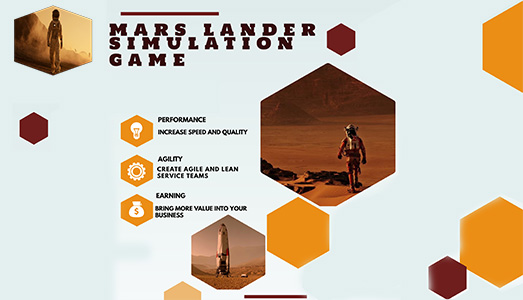“Agile service management involves adapting Agile and Scrum values and practices to ITSM processes and process design and improvement activities.”
Donna Knapp, Curriculum Development Manager,
ITSM Academy

“Agile service management involves adapting Agile and Scrum values and practices to ITSM processes and process design and improvement activities.”
Donna Knapp, Curriculum Development Manager,
ITSM Academy
The ITIL library was developed in the 1980s and has iteratively evolved over the decades. However, in today’s VUCA environment, traditional ITSM isn’t enough and is due for an upheaval. It needs more agility to adapt to the current environment and cater to customer needs.
Mars Lander is an intense and stimulating simulation that aims to lead individuals and teams from traditional ITSM practices towards the understanding and adoption of a more agile framework. The goal is to create self-motivation and internalize the need for agility in ITSM.
The primary focus of The Mars Lander Simulation is to support the Mission Center and achieve all mission goals. The Mars Lander needs to land on Mars, collect data, and return safely. Service Delivery needs to be agile, lean, and capable of responding to rapid change. Hence, getting the trainees on par with agile ITSM.
Topics for this course
Round 1 – Prepare for the mission
The team will start with a traditional structure, initially focusing on getting a clear picture of the current Service Requirements of Mission Control and dealing with a backlog of problems from the test phase. The Service Manager will define the required services and KPI’s.
Round 2 – Launch and Hardy IV encounter
In this round, the flight plan will bring the spacecraft into orbit around the Earth, directed towards Comet Hardy IV. The objective is to collect valuable research data from the comet and send it back to Earth. Mission Control makes new demands, real-time problems arise, and the flight course might need to be altered. At the end of the round, the team has to review its performance and map out improvements for the next service release.
Round 3 – Heading to Mars
In this round, the team is introduced to the concept of Service Teams. The team will learn how to increase flow, avoid rework, and create better and faster responses. Once the flight reaches Mars, the spacecraft has to orbit Mars twice for data collection. The crux of this round is to respond adequately to spontaneous demands from mission control, such as a request for 4K movies of the landscape of Mars. Vendor integration, service automation, and rapid end-to-end responses are critical for the success of the cycle.
Round 4 – Exploring the landscape of Mars
In this round, MarsLander has landed on Mars and starts its two trips traversing the terrain. The data has to be collected within a given time frame. The team has to ensure coordination with the vendors so that there is enough capacity to send and store data. All requests have to be supported on time. The multifunctional teams have to be supported by knowledge and experience sharing. This round is the last opportunity to achieve mission goals before putting Mars Lander into sleeping mode.